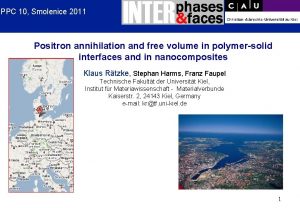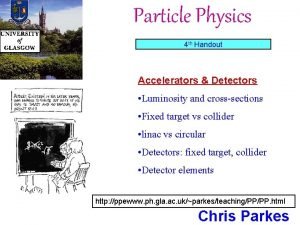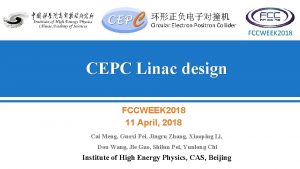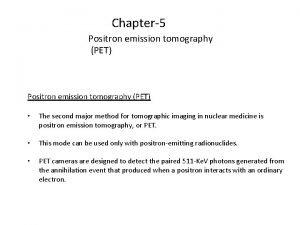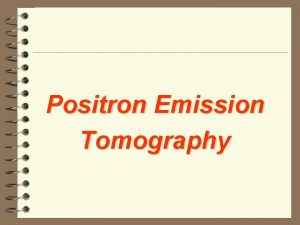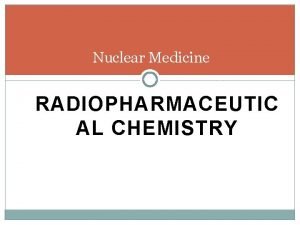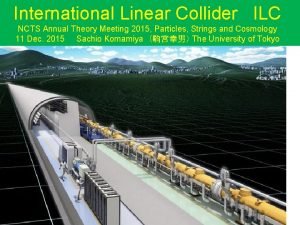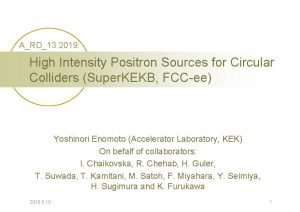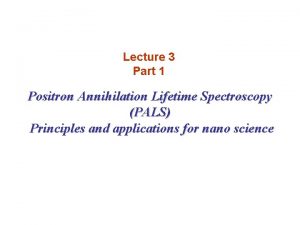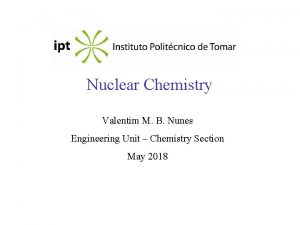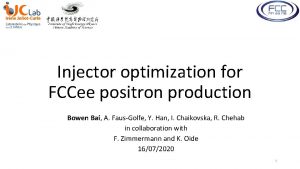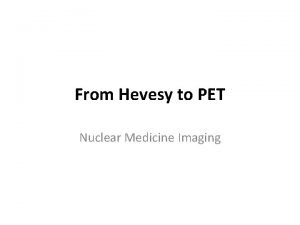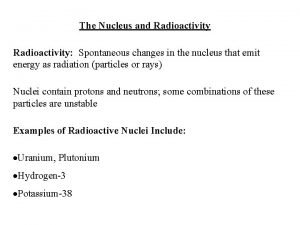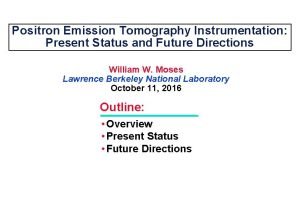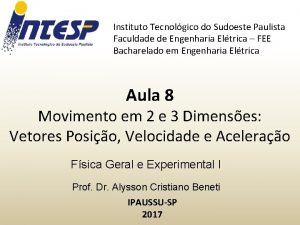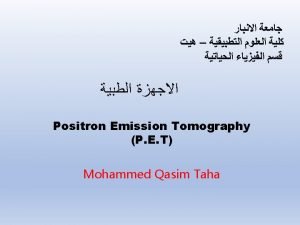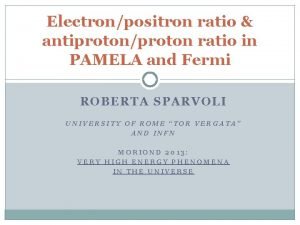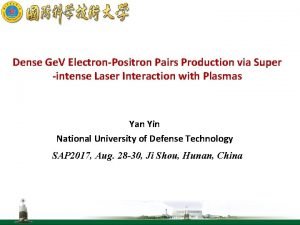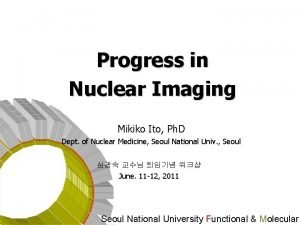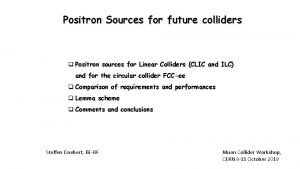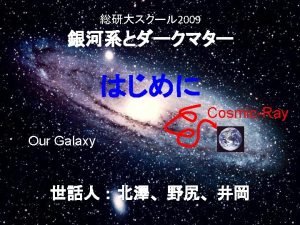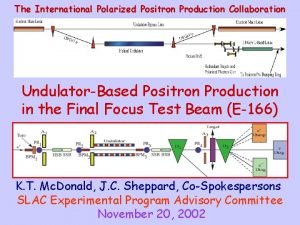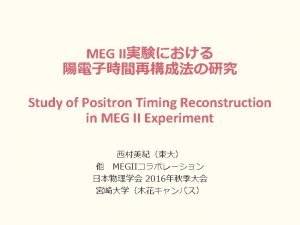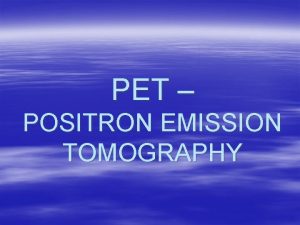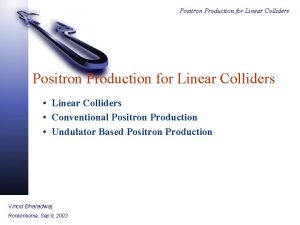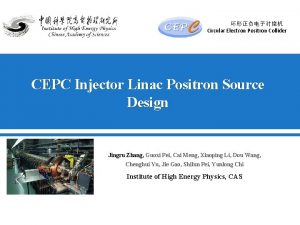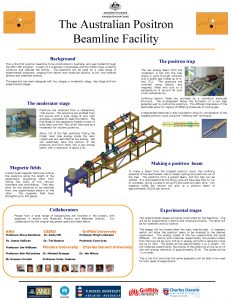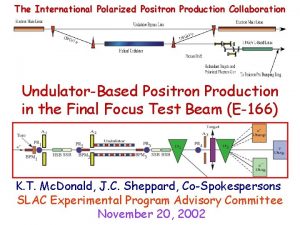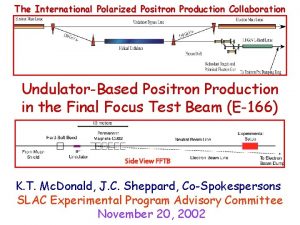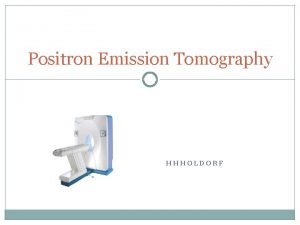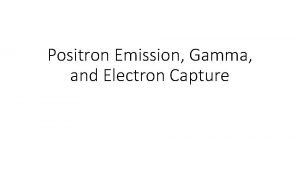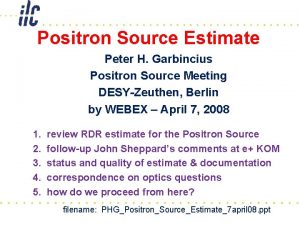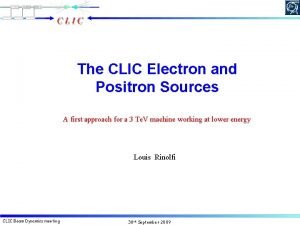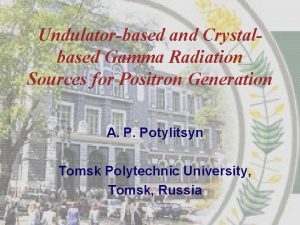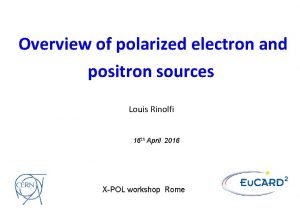Practical Challenges with Positron Sources q Positron sources













![Key element damping ring, CLIC example Injected Parameters e- e+ Bunch population [109] 4. Key element damping ring, CLIC example Injected Parameters e- e+ Bunch population [109] 4.](https://slidetodoc.com/presentation_image_h/e500fbe65d3a1bf3b112027e34ed0af2/image-14.jpg)






- Slides: 20

“Practical” Challenges with Positron Sources q Positron sources for Linear Colliders (CLIC and ILC) q Requirements for even more advanced colliders q Alternative positron sources q Conclusions

Typical requirements for a Positron Source for a collider for high energy physics q Delivers required intensity ~ 109 -1010 per bunch q Requires typically a yield of ~ > 1 if produced with primary electron beam q Extremely reliable and stable because the “complicated part” comes afterwards q Small energy spread before injection into damping ring DE/E ~ 1% q Extremely small emittance, needed for luminosity goals; implies flat beams Requires in general one or two damping rings ! q Synchronised with electron beam q Polarized beams preferred by physics q Low cost compared to collider total ( in reality a significant fraction) q Polarised electron beam (~80%) is “standard” for linear colliders

ILC positron source ~ 30% positron polarization

ILC positron source

CLIC complex

The CLIC Injector Complex > 1 km • • • Pre-damping ring can be avoided if the beam emittance is ~ < 25 mm (norm) Main damping ring; in: exn/eyn = 65/10 mm out: exn/eyn = 472/5 nm Bunch compressors needed after the rings for further acceleration

CLIC Positron Source q q q Generation of adequate photons (0 -20 Me. V) for pair production Complex and lossy positron collection and capture system Performance limited often by peak energy deposit density (PEDD < 35 J/g pulse) Very high radiation area, constraints for operation and maintenance, engineering challenge Long solenoidal field for guidance

Previous studies: The Pre-Injector Linac The total yield: 8. 0 e+/e- Aperture 20 mm ! 2. 8 e+/e- 1. 09 e+/e 0. 98 e+/e- (effective) e+ Target AMD Solenoid TW Structures The effective yield : (-20, 20) degrees in phase and (150, 250) Me. V in energy Total yield: 0. 89 e+/e. Effective yield: 0. 50 e+/e- Parameters of the accelerating structures in the Pre-Injector linac Parameters Unit Value Cell length cm 5 Frequency GHz 2 Phase advance per cell π 2/3 Average axial electric field MV/m 15 Acceleration Total yield: 0. 93 e+/e. Effective yield: 0. 48 e+/e- Deceleration C. Bayar

Injector Linac • All positrons are within 1% acceptance window of the pre-damping ring. The effective yield : (-20, 20) degrees in phase and (150, 250) Me. V in energy Energy (Ge. V) 5 (new) 5 (previous) 5 (CDR) Target exit (e+/e-) 7. 14 8. 00 AMD exit (e+/e-) 3. 06 2. 80 2. 10 Total yield (e+/e-) 1. 36 1. 09 0. 95 Effective yield (e+/e-) 1. 21 0. 98 0. 38 C. Bayar

Positron requirements / beam parameters D. Schulte, “Application of Advanced Accelerator Concepts for Colliders”, RAST, Vol 9, 2016 Parameter Unit [] ILC CLIC LPA PWFA DLA CMS energy / Luminosity [Te. V] / 1034 cm-2 s-1 0. 25 1. 8 3 6 3 10 3 6. 3 3 3. 2 Bunch charge N [109] 20 3. 72 1. 2 10 0. 0047 Bunch length [mm] 300 44 8 20 0. 0028 Emittance norm ex/ey [nm] 104/35 660/20 50/5 104/35 0. 1/0. 1 Bunches per train n 1312 1 1 1 Repetition rate [Hz] 5 50 84 k 10 -15 k 20 M Particles /s N [1014]/[s] 1. 3 0. 58 1. 0 1. 5 0. 94 § § Intensity probably OK with conventional technologies Emittance and bunch length for DLA beyond todays reach Emittance for LPA on the edge Repetition rates > 1 k. Hz needs study

Example: Laser-driven Plasma Accelerator (LPA) Parameters from Conventional positron source might be as well 1 km long ! Here is the tricky part

Example: Beam-driven Plasma Accelerator (PWFA) Assumes already LC-type sources

Example: Dielectric Laser Collider (DLA) R. J. England et al. Not many details on sources yet Positron source might be larger then the rest of the collider Very challenging emittance and repetition rates
![Key element damping ring CLIC example Injected Parameters e e Bunch population 109 4 Key element damping ring, CLIC example Injected Parameters e- e+ Bunch population [109] 4.](https://slidetodoc.com/presentation_image_h/e500fbe65d3a1bf3b112027e34ed0af2/image-14.jpg)
Key element damping ring, CLIC example Injected Parameters e- e+ Bunch population [109] 4. 7 Repetition frequenzy [Hz] 50 50 Bunch length [mm] 1 9 Energy Spread [%] 0. 1 1 Long. emittance [e. V. m] 2000 25700 0 H/V norm. emittance [nmrad] 100 x PDR 103 7 DR x 106 e-/e+ 4. 1 -4. 4 4. 1 Bunch length [mm] 10 1. 4 Energy Spread [%] 0. 5 0. 1 Long. emittance [e. V. m] 143000 5000 Hor. Norm. emittance [nmrad] 63000 500 Extracted Parameters Bunch population [109] DR complex challenges v Large injected emittances and energy spread Requirement of large DA and MA v Ultra low emittance at extraction Repetition time of 20 ms Fast damping requirement v PDR efficient injection of the large incoming beams v Main DR ultra-low emittance generation The positron beam needs at least 8 damping times to reach equilibrium (w/o taking into account injection, IBS, etc) The positron PDR is necessary! Ver. Norm. emittance [nm 1500 5 See for example: Y. Papaphilippou, “Reaching ultra-low emittance in the CLIC damping rings” rad]

Damping Ring and Transverse Emittances Can deliver O(104) bunches/s E. g. CLIC with 5 ns kickers could cool 200 bunches at any time Some beam dynamics issues but probably manageable 2008 Other solutions for electrons could be possible But for positrons that are created in collisions? LPA could be here Depends on DR energy DLA is down here CLIC D. Schulte ILC PWFA somewhere between CLIC and ILC

“Exotic” / Advanced schemes for positron production q Positrons from Laser acceleration q Positrons from ultra high field laser interaction q Positrons from electro-static traps q Primary electron accelerator could be based on advanced accelerator technologies and used in a classical positron production scheme q Plasma lenses for matching, plasma based capturing section could be attractive

Positrons from laser wakefield acceleration G. Sarri et al o o o High energy (600 Me. V) from the source High energy spread (50%) Emittance (~ um), likely damping ring still needed Possibly very short beams fs Charge ~ 108 total but small in reasonable bandwidth Future example Eu. PRAXIA: 5 x 106 positrons at 1 Ge. V, 5% bandwidth, 190 mm emittance

Positrons from electro-static traps o o Excellent emittance, no need of damping ring ? Very low energy ( ke. V) but low energy spread as well Long bunch length (ns) Low intensity and repetition rate (107 and 0. 1 Hz)

Positrons from very high field laser interaction M. Vranic et al. (see next talk) o o o High energy (>1 Ge. V) from the source High energy spread (50%) Emittance ? , likely damping ring still needed Possibly short beams ? Low intensity in useable bandwidth High energy electron LINAC needed and high power laser needed

Conclusions q Positron sources are by no means trivial q Already very challenging for conventional linear colliders, may be considered as state of the art q For advanced colliders main limitation comes from beam quality requirements for further transport and acceleration; emittance, energy spread and bunch length q Very high repetition rate likely very costly and challenging q Alternative positron sources need to be considered. Can we find a scheme which gets rite of the damping rings and provides equivalent or better beam quality q Without extremely stable and reliable source no luminosity !!!
 Positron yacht
Positron yacht Positron vs proton
Positron vs proton Positron
Positron Positron symbol
Positron symbol Positron emission tomography
Positron emission tomography Positron emission tomography
Positron emission tomography Annual theory meeting
Annual theory meeting Positron
Positron Gas separation
Gas separation Gamma particle
Gamma particle Positron
Positron Computed tomography
Computed tomography Cobalt-60 beta decay equation
Cobalt-60 beta decay equation Positron emission
Positron emission Positron emission tomography
Positron emission tomography Um coelho atravessa um estacionamento
Um coelho atravessa um estacionamento Positron emission
Positron emission Cirelli
Cirelli Positron vs electron
Positron vs electron Positron emission tomography
Positron emission tomography Print sources and web sources
Print sources and web sources
